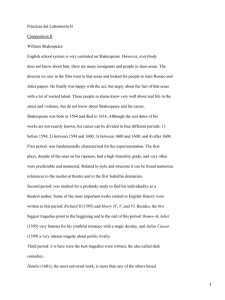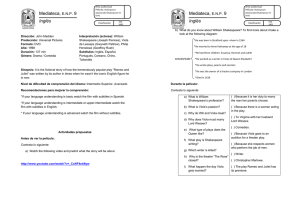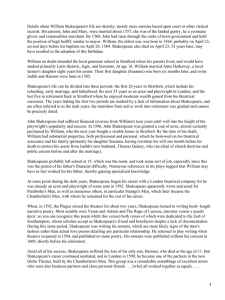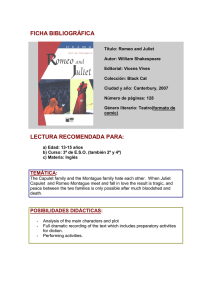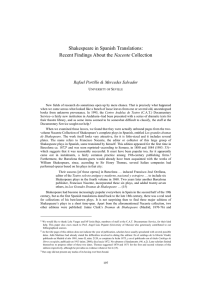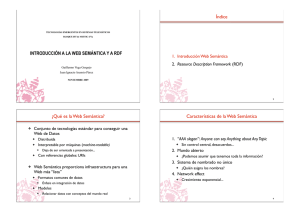full text
Anuncio
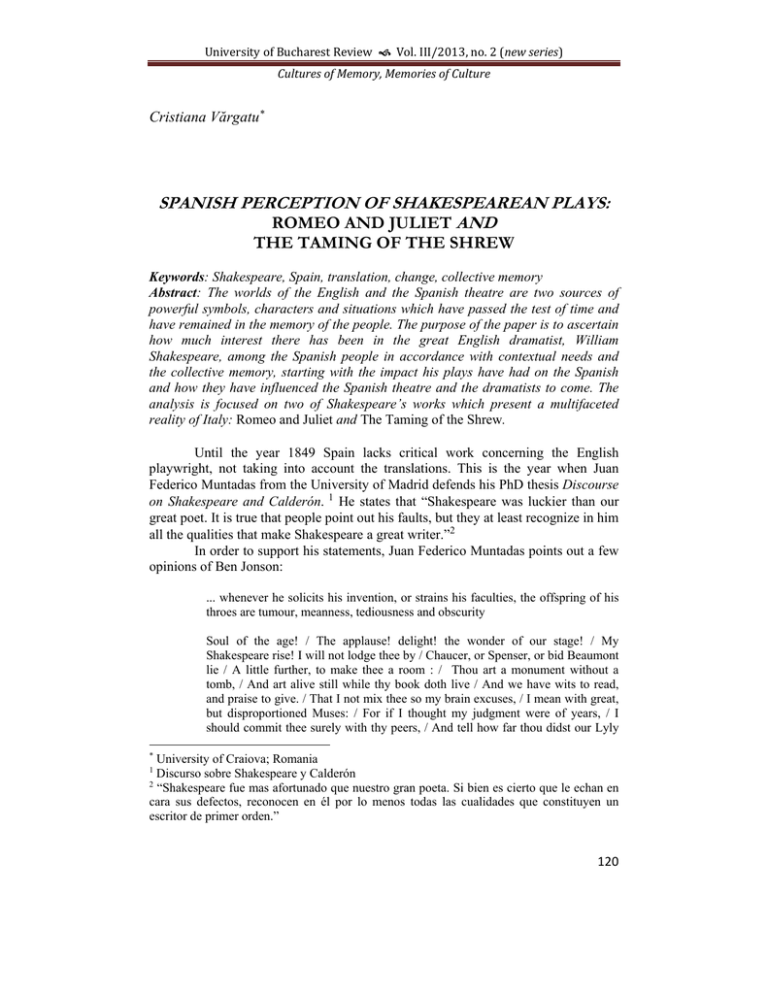
UniversityofBucharestReviewVol.III/2013,no.2(newseries) CulturesofMemory,MemoriesofCulture Cristiana Vărgatu* SPANISH PERCEPTION OF SHAKESPEAREAN PLAYS: ROMEO AND JULIET AND THE TAMING OF THE SHREW Keywords: Shakespeare, Spain, translation, change, collective memory Abstract: The worlds of the English and the Spanish theatre are two sources of powerful symbols, characters and situations which have passed the test of time and have remained in the memory of the people. The purpose of the paper is to ascertain how much interest there has been in the great English dramatist, William Shakespeare, among the Spanish people in accordance with contextual needs and the collective memory, starting with the impact his plays have had on the Spanish and how they have influenced the Spanish theatre and the dramatists to come. The analysis is focused on two of Shakespeare’s works which present a multifaceted reality of Italy: Romeo and Juliet and The Taming of the Shrew. Until the year 1849 Spain lacks critical work concerning the English playwright, not taking into account the translations. This is the year when Juan Federico Muntadas from the University of Madrid defends his PhD thesis Discourse on Shakespeare and Calderón. 1 He states that “Shakespeare was luckier than our great poet. It is true that people point out his faults, but they at least recognize in him all the qualities that make Shakespeare a great writer.”2 In order to support his statements, Juan Federico Muntadas points out a few opinions of Ben Jonson: ... whenever he solicits his invention, or strains his faculties, the offspring of his throes are tumour, meanness, tediousness and obscurity Soul of the age! / The applause! delight! the wonder of our stage! / My Shakespeare rise! I will not lodge thee by / Chaucer, or Spenser, or bid Beaumont lie / A little further, to make thee a room : / Thou art a monument without a tomb, / And art alive still while thy book doth live / And we have wits to read, and praise to give. / That I not mix thee so my brain excuses, / I mean with great, but disproportioned Muses: / For if I thought my judgment were of years, / I should commit thee surely with thy peers, / And tell how far thou didst our Lyly * University of Craiova; Romania Discurso sobre Shakespeare y Calderón 2 “Shakespeare fue mas afortunado que nuestro gran poeta. Si bien es cierto que le echan en cara sus defectos, reconocen en él por lo menos todas las cualidades que constituyen un escritor de primer orden.” 1 120 UniversityofBucharestReviewVol.III/2013,no.2(newseries) CulturesofMemory,MemoriesofCulture outshine, / Or sporting Kyd, or Marlowe's mighty line. / And though thou hadst small Latin and less Greek, / From thence to honour thee, I would not seek / For names : but call forth thund'ring Aeschylus, / Euripides, and Sophocles to us, / Pacuvius, Accius, him of Cordova dead, / To life again, to hear thy buskin tread / And shake a stage : or when thy socks were on, / Leave thee alone for the comparison / Of all that insolent Greece or haughty Rome / Sent forth, or since did from their ashes come. / Triumph, my Britain, thou hast one to show / To whom all Scenes of Europe homage owe. Actually, Muntadas mistakenly assigns the first quotation to Ben Johnson. Those lines were written by Samuel Johnson in the preface of his edition of Shakespeare`s works, in 1765. The second quotation is Ben Johnson`s from To the Memory of My Beloved the Author, Mr William Shakespeare which was written for the first edition of Shakespeare`s dramatic works (1623). Years later, two articles appeared in El Museo Universal signed by Luis Carreras which were entitled Shakespeare, the first one on the 22nd of April 1866 and the second one on the 6th of May of the same year. They are incomplete, although they are more accurate than other later writings. The author formulates the hypothesis that the personality of Shakespeare must have been influenced by the hardships suffered in the first years of his life in London. But the most important part of this work is his commentary on the dramatic poems and observation regarding the various literary devices discovered in Shakespeare`s works in every period of his life. The interest of the Spanish theatregoers in Shakespeare and the culture he stood for grew even stronger around this period and two theatrical portraits followed, one derivative, the other entirely original. The first one was entitled Guillermo Shakespeare (1853) and was written and produced by Enrique Zumel, who also starred in it. Guillermo Shakespeare is based on a Spanish translation of the French novel by Clemence Rober that portraits Shakespeare as the virtuous and handsome brother of the scheming Caliban, torn by his feelings for Isabel, daughter of the Earl of Southampton, and Ariela, a simple and selfless actress. The second one was written by Manuel Tamayo y Baus and was entitled Un drama Nuevo (A New Play). Unlike Guillermo Shakespeare which run for only four nights, Un drama nuevo was very popular. In this play, Shakespeare is an established playwright who, despite his reservations, agrees to let the company fool Yorick play the main role in his new play, only to discover that the so-called fictional plot resembles the real relationship between the ageing Yorick, his wife, Alicia, and her platonic lover, Edmundo. It also employs episodes of Romeo and Juliet, Hamlet and Othello. Un drama nuevo was first performed on the stage of the Theatre of Zarzuela, on the 4th of May 1867 and, even though his author used a pseudonym (Joaquín Estébanez), it was well-known that the play was written by Manuel Tamayo y Baus. It was performed in Spain throughout the 19th and early 20th centuries and was adapted in 1946 for the Spanish cinema. It was also known to audiences in France, Germany, Italy and in the United States, where it was produced in 1874 under the title Yorick. The play has been published in English as A New 121 UniversityofBucharestReviewVol.III/2013,no.2(newseries) CulturesofMemory,MemoriesofCulture Drama, translated by John D. Fitzgerald and Tacher H. Guild, and in German as Das Neue Drama, translated by Otto Goldschmidt. Referring to the Spanish perception of Shakespeare and his plays, Tamayo himself assesses the impact of the author`s work in his address to the Spanish Royal Academy, La verdad considerada como fuente de belleza en la literatura dramatic (Truth conceived as the source of beauty in dramatic literature): Recall the world animated in the sphere of art by the presiding genius (numen) of Shakespeare. Therein we find the infinite variety of Nature, each character distinguished from the rest by a physiognomy of his own; therein the human being with neither mutilation nor amendment, prompting both pity and admiration; therein the innermost impulses of the will, the most abysses of the mind and heart; therein Lady Macbeth, Juliet, Desdemona, Shylock, Richard III, Macbeth, Othello, Romeo, Hamlet, Lear, seemingly brought to life by an authentic soul; therein a portraiture of humanity itself in all its stages, at its most imposing and expressive; and this is why the name of Shakespeare extends to every corner of the globe (Un drama nuevo 39). In what follows, the main focus is going to be on certain early translations of two of Shakespeare`s works which present a multifaceted reality of Italy: Romeo and Juliet and The Taming of the Shrew. Regarding this issue, Isabel Verdaguer states in Shakespeare’s “Poem Unlimited” in Eighteenth-Century Spain that: The history of Shakespeare translations into Spanish reveals one clear tendency from the accuracy pole towards the adequacy pole. The earliest translations were heavily determined by the norms of the receiving culture, and consequently nearer the acceptability pole. The more modern a translation gets, the more likely it is to aim at reproducing the original text as accurately as possible (132). A difficult issue arises when dealing with the first appearance of Romeo and Juliet in Spain. “On the 9th of December another Shakespearean drama had its premiere on the stage of the theatre of Cruz, beautifully translated from Dutch by Dionisio Solís, as all the versions made by this famous and well known poet,” stated Emilio Cotarelo y Mori (187), mentioning also that “there is a manuscript of this work in the City Library but we should note that the content is different from another romance pentameter version which was printed in Barcelona and in Valencia in 1820, also attributed to Solis.” The distinction between the two is very interesting. Eduardo Julia Martinez points out in his work, Shakespeare in Spain – Translations, Imitations and Influence of Shakespeare in the Spanish Literature (Shakespeare en España – traducciones, imitaciones e influencia de Shakespeare en la literatura española), the fact that the latter is a more exact version of the translation in Dutch, whereas the first one has an inexplicable liberty. Why did Solis’ translation change from a more freely style to an almost literal translation? The next representation of Romeo and Juliet is entitled Mónteseos y Capulefos, a lyrical tragedy written by Félix Romani, played on the stage of the 122 UniversityofBucharestReviewVol.III/2013,no.2(newseries) CulturesofMemory,MemoriesofCulture same city. The author stated that he had to make some changes both to differentiate the drama from the version already known by the public and to arrange the scenes in order to fit the rhythm of the music. On the 17th of April 1849 a tragedy written by Victor Balaguer is published, entitled Julieta y Romeo, which had three acts dedicated to “Cayetano de Villalonga y de Marimón, Baron de Segur, maestrante de la Realde Valencia y diputado provincial de Barcelona”. At the end of his work, Victor Balaguer talks about what he had written: “I don’t know if my work is a tragedy; I only know that Julieta y Romeo is the work of my heart as Flores del alma is the work of my vengeance. I don`t know anything else than the fact that my Juliet is not Shakespeare`s Juliet or Soulié`s Juliet or Rojas` Juliet. My Juliet is mine, is the Juliet that I know, respect and admire; a Juliet to whom I owe the few sunny days that have brightened my hectic life.” (“Yo no sé si mi obra es tragedia; yo no sé más sino que Julieta y Romeo es mi obra del corazón, como fueron mis Flores del alma la obra de mi venganza. … Yo no sé más sino que mi Julieta no es ni la Julieta de Shakespeare, ni la de Soulié, ni la de Rojas. Mi Julieta es una Julieta mía, que yo conozco, que yo respeto, que yo admiro; una Julieta a la cual debo los pocos días de sol que han alumbrado mi agitada vida.”) Hiráldez Manuel Acosta is the author of another version published in the 6th Volume of, the Select, Ancient and Modern, National and Foreign, Collected and Illustrated Theatre with An Introduction, Notes, Biographical and Critical Observations of the Main Authors by Francisco José Orellana and Cayetano Vidal y Valenciano. He used a great freedom in translating Shakespeare`s work without the slightest warning. A version of Romeo and Juliet was part of the 3rd volume of the collection Works of William Shakespeare faithfully translated from English in the presence of first editions and texts brought forth by the most celebrated commentators of the immortal poet, by his Excellency Matías de Velasco y Rojas, Marquis de Dos Hermanas (Teatro selecto antiguo y moderno, nacional y extranjero, coleccionado e ilustrado con una introducción, notas, observaciones críticas y biográficas de los principales autores). This volume was printed in Madrid in 1872. The versions of the Marquis de Dos Hermanas had been made with great affection and boundless admiration for the English poet. Each one had an introduction and many notes. Some of the notes were inserted at the bottom of the page, indicating the versions, and others at the end, serving as commentaries, even though philological, regarding the customs and even the sources which Shakespeare might have used for his work. However, when it comes to the translation in question, it is not as artistically as Shakespeare`s work and it is not even faithful to it. For instance, Daniel Lopez states in his work Shakespeare in Spain (Shakespeare en España) that during the famous farewell of the two lovers the reader wants to sense the tender simplicity of the English version which is full of passion, love, drama and sensitivity. But in the Spanish version, all these feelings disappear and, instead of reading a drama, one may have the feeling that one is reading a treaty of philosophy in which the ideas are exposed in a very clear and simple manner. 123 UniversityofBucharestReviewVol.III/2013,no.2(newseries) CulturesofMemory,MemoriesofCulture A collection of Shakespeare`s works appeared in 1875, a collection which is a powerful element on the journey to discovery the manner in which his plays became known to the Spanish public. The collection was written by Jaime Clark and it was entitled Shakespeare’s Works (Obras de Shakespeare). It was published in five volumes in Madrid, Medina y Navarro. It is important to state that the author was born in Naples, then lived in Germany and, in the spring of 1864, he moved to Spain. The fact that he knew three languages, Italian, German and Spanish, made possible for him to interpreter Shakespeare`s works with scrupulous precision. But the author himself confesses in some occasions that there are some word games that are impossible to translate into castellan without losing their effect. For instance, in Act 1, Scene 1, in a conversation between Gregory and Samson: Sampson: 'Tis all one. I will show myself a tyrant. When I have fought with the men, I will be civil with the maids. I will cut off their heads. Gregory: The heads of the maids? Sampson: Ay, the heads of the maids, or their maidenheads; take it in what sense thou wilt. It is translated as: Gregory: ¿Las cabezas de las doncellas? Sampson: Sí, las cabezas de las doncellas o su doncellez; tómalo en el sentido que quieras. Maidenhead means virginity. Therefore, Sampson is saying that he will take their heads or take their virginity (maidenhead). This means that Gregory can interpret what he said however he wants: either as Sampson killing the women or raping them. Another author which had a key role in disclosing Shakespeare`s works in Spain was Guillermo Macpherson. Between 1873 and 1897 he translated 23 of his works from the German version of August Wilhem Schlegel. The first was Hamlet, Prince of Denmark (Cadiz, 1873) between 1879 and 1882 seven others were published in Madrid, including a review of Hamlet in 1879, two editions of Romeo and Juliet (1880 and 1882), Macbeth (1880), Othello (1881) and Richard III (1882). His translations were characterized by conciseness and effectiveness and they were said to be more direct than those of Clark`s, reflecting at the same time even better the Shakespearean world. Each of the 23 works translated by him had an extensive prologue. According to Alfonso Par, if somebody had edited his prologues in order to form one book, it would have been the best book of criticism of Shakespearean plays of his time. For instance, the prologue of Romeo and Juliet is a brief and accurate study of the work, which identifies the sources that the English writer might have used, states the interest the Stratford playwright had for his tragedy and analyses the great relief of the characters achieved in the development of the action. 124 UniversityofBucharestReviewVol.III/2013,no.2(newseries) CulturesofMemory,MemoriesofCulture Concerning the Spanish translations of The Taming of the Shrew, there had been many but there were not so many different versions as in the case of Romeo and Juliet. The first version is signed by Pablo Soler, entitled Una furia domeñada (A Tamed Fury), and it appeared in the Nacente Collection on pages 235-266 of the first volume. The version of this play signed by Guillermo Macpherson appeared in the 6th volume of Shakespeare’s Works and the author inserts in the Prologue of his work data concerning the relation between Shakespeare’s play and certain stories, especially concerning the Book of the Examples of Count Lucanor and of Patronio (Libro de los ejemplos del conde Lucanor y de Patronio) which is entitled Of what happened to a young Man on his Wedding Day (De lo que contesció a un mancebo que casó con una mujer muy fuerte et muy brava). This book was published in Seville in 1575. The protagonist of Don Juan Manuel`s story faces the same problem as Petruchio: each man marries a rich woman who had one terrible fault: she was a fierce and strong woman, a perfect shrew. Therefore the action of both works involves prompting the wife to submit. The 3rd translation of Shakespeare`s The Taming of the Shrew is part of the 15th volume of the Ancient and Modern Theatre (Teatro Antiguo y Moderno) which was published in Barcelona, in 1904. It was structured in 5 acts and a prologue and the Castilian translation was attributed to Antonio de Vilasalba. Actually this version is formed out of the mixture of the previous 2 versions. There are other 2 versions of The Taming of the Shrew, published on 2 separate occasions, with distinct titles attributed to Manuel Matoses: La fierecilla domana, comedy in 4 acts in prose published in Madrid in 1895 and La Indomita, comedy in 3 acts also in prose published in Madrid in 1897. Manuel Matoses does not include the prologue and the majority of the scenes of the first act of the English version and, in his second version, he does not include the entire second act from La fierecilla domana where he inserted the wedding scene and with the development of the situation between Petruchio and Katherine. In 1896, inspired by The Taming of the Shrew, José López Silva and Carlos Fernández Shaw wrote a one-act play called “sainete” entitled The Brave (Las Bravias), music of Ruperto Chapí. The action takes place in Madrid and the characters belong to the lower class of the Court. Another version of this play was put together by Gregorio Martínez Sierra in April 1916 in a theatre in Eslava entitled Domando la tarasca, tarasca meaning monster, carnival dragon, a person who drains one`s resources. One interesting element when discussing The Taming of the Shrew is the fascinating history of gender in Spanish performances of Shakespeare‘s work. For instance, the public reaction regarding the Taming of the Shrew written by Juan Guerrero Zamora in 1975, which became a plea for equal rights between men and women. This reaction was due to the fact that the author had changed the ending of the play. Instead of the final speech of submission, Katherine appears in jeans, claiming the rights of women. From the point of view of the critics, this was intolerable. Katherine expressed the desire of women to have a relationship of equality with men, not to submit to the will of man. 125 UniversityofBucharestReviewVol.III/2013,no.2(newseries) CulturesofMemory,MemoriesofCulture This version of the play represented a sign of change which was not only being manifested in theatres but it was also a reflection of a society which was demanding freedom and, in particular, freedom of women. Taking into account the translations referred to in this paper, it is hard to achieve a perfect translation that reflects each and every one of the meanings of the work in question without losing the poetic tone of the text one wants to translate. The translation is, up to a certain point, a subjective approach offered by an author to try to play in the mind of the receiver, in the target language, the same sensations that the text in the source language causes. Therefore, the main problem identified, especially when talking about early translations, is the fact that books were not being translated from English but from other languages in which the books in question had been previously translated. As stated above, the authors who translated Shakespeare`s works made some changes in the action of the play without previously mentioning this. The changes varied from the insertion/removal of secondary characters, modifications in the background and main features of the characters, to changes regarding the ending of the play. There are also examples of Spanish particularities in the translations, such as the appearance of Shakespeare himself in several of the plays or the description of regional diversity, which is characteristic to the Spanish theatre. Spanish theatregoers and readers, when coming in contact with these versions of Shakespeare`s plays, had the impression that the sequences of events, the characters and the conclusions to be drawn are the result of William Shakespeare`s imagination and will. Therefore the Spanish perception of the English playwright figure was sometimes based on altered or false information which influenced the collective memory of the people concerning him and his plays. Works Cited Cotarelo y Mori, Emilio. Isidoro Máiquez y el teatro de su tiempo. Madrid: J. Perales y Martínez, 1902. (<http://archive.org/stream/isidoromaiquezye00cotauoft#page/n1/mode/2up>. 30 May 2013). Julia Martinez, Eduardo. Shakespeare en España – traducciones, imitaciones e influencia de Shakespeare en la literature española. Madrid: Revista de Archivos, 1918. (<http://archive.org/stream/shakespeareenesp00juliuoft#page/2/mode/2up>. 30 May 2013). Kern, Robert W. The Regions of Spain: A Reference Guide to History and Culture. Westport, CT: Greenwood, 1995. Questia School. Web. 2 June 2013. Pujante, A. Luis and Ton Hoenselaars, eds. Four Hundred Years of Shakespeare in Europe. Newark, DE: University of Delaware, 2003. Questia School. Web. 1 June 2013. Shakespeare, William. The Works of William Shakespeare Gathered into One Volume. New York: Oxford UP, 1938. Questia School. Web. 25 May 2013. 126 UniversityofBucharestReviewVol.III/2013,no.2(newseries) CulturesofMemory,MemoriesofCulture Tamayo y Baus, Manuel. La verdad considerada como fuente de belleza en la literatura dramática. Madrid: M. Rivadeneyra, 1859. (<http://archive.org/stream/discursosleidosa00tama#page/n3/mode/2up>. 30 May 2013) Verdaguer, Isabel. Shakespeare's “Poem Unlimited” in Eighteenth-Century Spain in Translating Shakespeare for the Twenty-First Century. Amsterdam: Rodopi, 2004. Dqr Studies in Literature. Questia School. Web. 1 June 2013. 127
